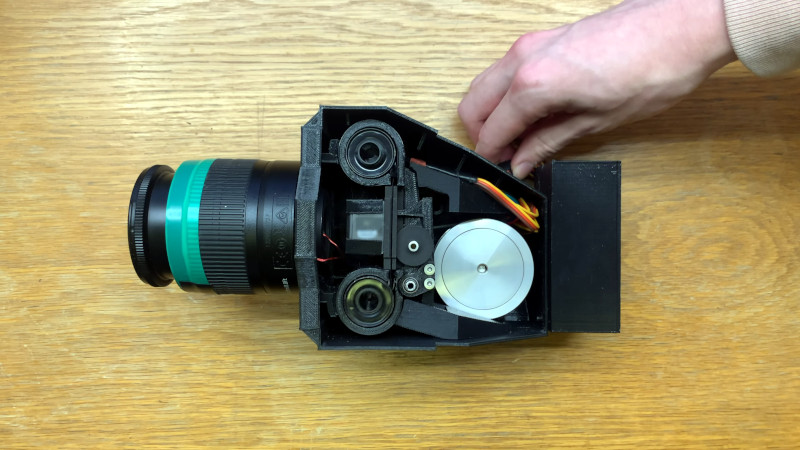When the British budget electronics brand Amstrad released their first budget VHS camcorder in the mid 1980s, they advertised it as making a filmmaker out of everyone. Now everyone truly is a filmmaker of sorts with their always-handy mobile phones, even though possessing a camera does not give you the talent of Steven Spielberg.
Such easy access to video hasn’t dimmed the allure of old-style film though, and there is a band of enthusiasts who seek out the older medium. [Joshua Bird] is one, and he’s produced a rather special 3D printed camera that can capture short videos on a standard roll of 35mm camera film. The downside is that, at the going rate, filming your masterpiece comes out to approximately $600 USD for each 10 minutes of footage. Better keep that dense exposition to a minimum.
The two most important mechanisms in a movie camera are the shutter and the film advance. The first is a disc that spins once a frame with an arc-shaped aperture over a section of it to let the light through, while the second is a hook that engages with the film once a frame after the shutter aperture has passed, to advance it to the next frame. Designing these to work in printed form is no easy task, and [Joshua] takes the reader through the various twists and turns in their development. Beyond that he takes a novel approach to a through-the-lens viewfinder, eschewing a split prism for an angled mirror on the shutter disk.
With each frame taking a fraction of the 35mm frame it’s clear from the video below that this doesn’t deliver the highest quality image. But that’s not the point of a device like this, above all it’s a working movie camera that he made himself. Since some of us have interests in that direction, dare we say we’re envious? Meanwhile, this isn’t the first 3D printed movie camera we’ve brought you.
















Well, it needs work…
My father made better movies with a Beaulieu sixty years ago.
Great work though !
Well done I say. Reminds me of 8mm footage. I like it!
I shoot Kodak Color 35mm @ 24fps
648 shots in a $130 100ft roll (even cheaper by the case)
works out to 27 mins at ~$4/min
648/24=27 seconds = $4/second
Is that including development and telecine scanning? Those always have been the nice hidden costs.
Help me out with the math please:
648 shots / 24fps = 27 sec.
That gives me 0.45 min at ~290$/min
Super very nice I like
Nice! And for cinematic productions that cost/min is low…
I smell $$$$$
I was interested in how it was tiling these small frames onto the film, but it wasn’t clear from skimming the documentation. Looking at the pictures, I think it just exposes one edge of the film “as normal” (but snaller), and then you have to take the film out and turn it round to expose the other side, much like with audio tape.
What would be really cool is a mechanism to expose a bunch of mini frrames in a grid on a strip of medium format film (rotating prism?), and then you could use the same mechanism to project the developed transparency. Since that would make a 35mm lens so much faster, you could maybe shoot 20 or 30 seconds on a roll of Velvia 50. That would be nice.
I love the quality. Looks better than Super-8. Nice work!
I noticed this camera uses (what looks like about) half the width of the film. “Double 8” home movie cameras exposed exactly 1/2 of 16mm film stock, so you could shoot both sides for double the time. (It was sliced in half by the film lab for projection.) It would be awesome if this camera did that too.
To anyone who says “but 10 seconds is so short,” I say 10 seconds is perfect! It’s 1/6th of a TikTok video. My Sony MiniDV camera even has a “10s” mode because people get bored easily. They want the filmmaker to move to the next shot.
Finally: Am I the only one who finds it odd to read “capture short videos on … film”? (Yes, I do recognize that words change meaning over time, and “videos” now refer to any moving picture sequence regardless of the source.)
Oops, I should have read Josh Bird’s web site before commenting. This camera does almost exactly what an old “Double 8” camera does to maximize the number of frames per roll.
Hmm video = movie picture to me, so… Since film is rarely used for that in consumer settings, it makes sense to express surprise. (I take the work “movie” to be more specific, usually like a two hour commercial movie, or at least something taken specifically to watch later like a “home movie”, whereas to me “video” is more of a technical term for anything with multiple frames strung together with sound).
As for people getting bored easily, sounds like their own issue.
That was beautiful. Haunting, even, with that excellent music. I really feel like I’ve seen a slice of this guy’s life, presented as a moving work of art.
“Beyond that he takes a novel approach to a through-the-lens viewfinder, eschewing a split prism for an angled mirror on the shutter disk.”
A mirrored shutter disc is hardly uncommon for movie cameras with TTL viewfinders, e.g. the ubiquitous Arriflexes.
I love the work made, including the machine vision scanner to align the image. Besides the “600usd per minute” I think it proves that movie cameras can be developed again by amateurs, like the Logmar S-8, and the Kodak one.